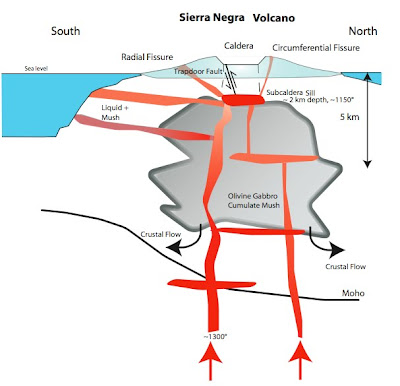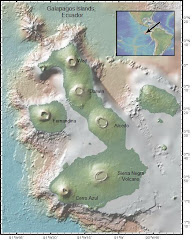Most oceanic shield volcanoes, like Hawaii and Iceland, form and grow through a process of rifting, dike intrusion and faulting. Their shape is broad and gently rounded, like a warrior’s shield. They form as flow after flow of basaltic lava erupts and spreads over a wide area. A physical inspection and comparison of the islands of Hawaii and Isabela (see Figure 1 and Figure 2) shows some similarities and differences among these oceanic hotspot volcanoes. All of the volcanoes fit the warrior’s shield shape criteria, but there are clear differences in the vent sites where lava erupts. Hawaii has long, linear fissure vents, and the volcanoes of Isabela Island all have large craters. One of the questions we hope to answer is why lava is extruded in a different way on these Galápagos volcanoes? Other questions aren’t as physically obvious and involve the models that fit existing geologic and geophysical data. Seismic and geologic data suggest that the best model for the Hawaiian Islands’ hotspot involves a thickened, bulging mantle overlain by thinned oceanic crust. Data from the Galápagos hotspot fits a contrasting model, one with thickened crust that builds up as magma from the mantle pools and differentiates in the crust before it erupts. These models are known respectively as “underplating” and “overplating.” Using geodesy in combination with seismic reflection data is a new way to test the Galápagos hotspot model. It is also a way to refine the use of space geodesy by developing techniques to image both the shape and movement of the magma chamber that underlies Sierra Negra volcano. This in turn may answer questions about how magma moves through Earth’s crust. When all of the new data from this expedition is integrated to create a 4D model of the internal structure of Sierra Negra volcano, the model for the Galápagos hotspot can be refined.

Figure 1. Hawaii

Figure 2. Isabela

Figure 3. Conceptual ‘overplate’ model of Sierra Negra magmatic plumbing system. Red denotes magmatic dikes(conduits) and sills (reservoirs). The top of the magma system is a mostly liquid sill, whose top is -2 km beneath the caldera floor, but its lateral and vertical dimensions are only loosely constrained (see point 2 ). Beneath this is a thick olivine-gabbro mush, which slowly solidifies as the volcano is carried away from the hotspot.
For more information about shield volcanoes:
http://vulcan.wr.usgs.gov/Glossary/ShieldVolcano/description_shield_volcano.html
http://www.mbari.org/volcanism/Hawaii/Default.htm
